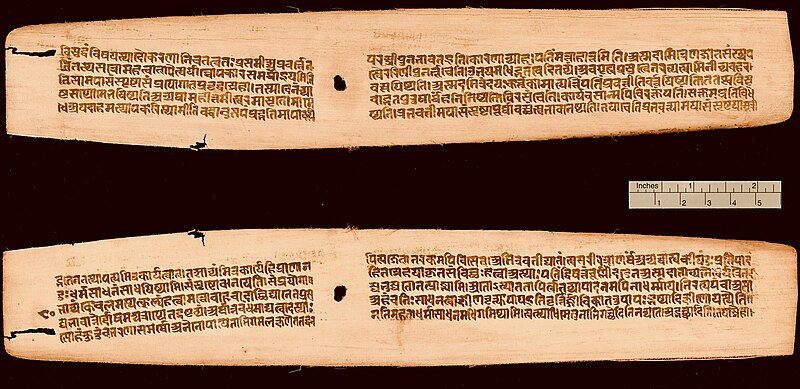File:3rd or 4th century CE Kamasutra Vatsyayana, verse 1.5.10–12, 13th-century Jayamangala commentary of Yashodhara, Bendall purchase 1885CE in Nepal, Sanskrit, Devanagari front and back folio.jpg

Original file (3,894 × 1,892 pixels, file size: 1.79 MB, MIME type: image/jpeg)
Captions
Captions
Summary[edit]
| Description3rd or 4th century CE Kamasutra Vatsyayana, verse 1.5.10–12, 13th-century Jayamangala commentary of Yashodhara, Bendall purchase 1885CE in Nepal, Sanskrit, Devanagari front and back folio.jpg |
English: The Kama Sutra is a Hindu text, whose title literally means "a treatise on desire / emotional pleasure / love / sex". It is likely a 3rd- or 4th-century CE text according to scholars, but some estimates place it centuries before or after that range. It is a Sanskrit text by Vatsyayana Mallanaga. Vatsyayana mentions in the Kama Sutra that his work relies on earlier Kama sastra texts. He cites them, but these older texts have not survived into the modern era. The Kamasutra exists in many Indic scripts. Being a sutra, it is terse and distilled.
The text has attracted scholarly studies since the ancient times, and these are called bhasya (commentaries that include interpretation, citations and views of the scholar). It is one of many popular Hindu text that has attracted translations in and outside India over the centuries. One of the most important and well-known commentaries on the Kama Sutra is by Yashodhara, named Jayamangala (c. 13th-century). The manuscript above is a commentary copied in Nepal possibly in 13th- or 14th-century CE, but not the main (mula) text. Though nicely written and well preserved, this manuscript is quite corrupt and has mistakes unlike other manuscripts found on the Indian subcontinent. This flawed manuscript version is currently preserved by the Cambridge University. The errors in this manuscript possibly resulted because the scribe who was copying relied on a source in a different script that the scribe did not know well, since complex ligatures (i.e. consonant clusters) are often erroneously reproduced, according to a Cambridge University archiver's note. This palm-leaf manuscript shows sign of age-related irregular warping and insect-eating damage, pretty common in South Asian climate. This manuscript was purchased by C. Bendall in 1884 or 1885 CE in Nepal, and was produced in or before this acquisition year. The photo above is of a 2D artwork from the text that was itself authored more than 500 years ago. Therefore Wikimedia Commons PD-Art licensing guidelines apply. Any rights I have as a photographer is herewith donated to wikimedia commons under CC 4.0 license. |
| Date | |
| Source | Own work |
| Author | Ms Sarah Welch |
Licensing[edit]
- You are free:
- to share – to copy, distribute and transmit the work
- to remix – to adapt the work
- Under the following conditions:
- attribution – You must give appropriate credit, provide a link to the license, and indicate if changes were made. You may do so in any reasonable manner, but not in any way that suggests the licensor endorses you or your use.
- share alike – If you remix, transform, or build upon the material, you must distribute your contributions under the same or compatible license as the original.
File history
Click on a date/time to view the file as it appeared at that time.
| Date/Time | Thumbnail | Dimensions | User | Comment | |
|---|---|---|---|---|---|
| current | 16:03, 28 October 2018 |  | 3,894 × 1,892 (1.79 MB) | Ms Sarah Welch (talk | contribs) | User created page with UploadWizard |
You cannot overwrite this file.
File usage on Commons
There are no pages that use this file.
File usage on other wikis
The following other wikis use this file:
- Usage on te.wikipedia.org
Metadata
This file contains additional information such as Exif metadata which may have been added by the digital camera, scanner, or software program used to create or digitize it. If the file has been modified from its original state, some details such as the timestamp may not fully reflect those of the original file. The timestamp is only as accurate as the clock in the camera, and it may be completely wrong.
| Date and time of data generation | 04:33, 28 October 2018 |
|---|---|
| Horizontal resolution | 72 dpi |
| Vertical resolution | 72 dpi |
| File change date and time | 04:33, 28 October 2018 |
| Date and time of digitizing | 04:33, 28 October 2018 |
| Color space | Uncalibrated |
| IIM version | 2 |